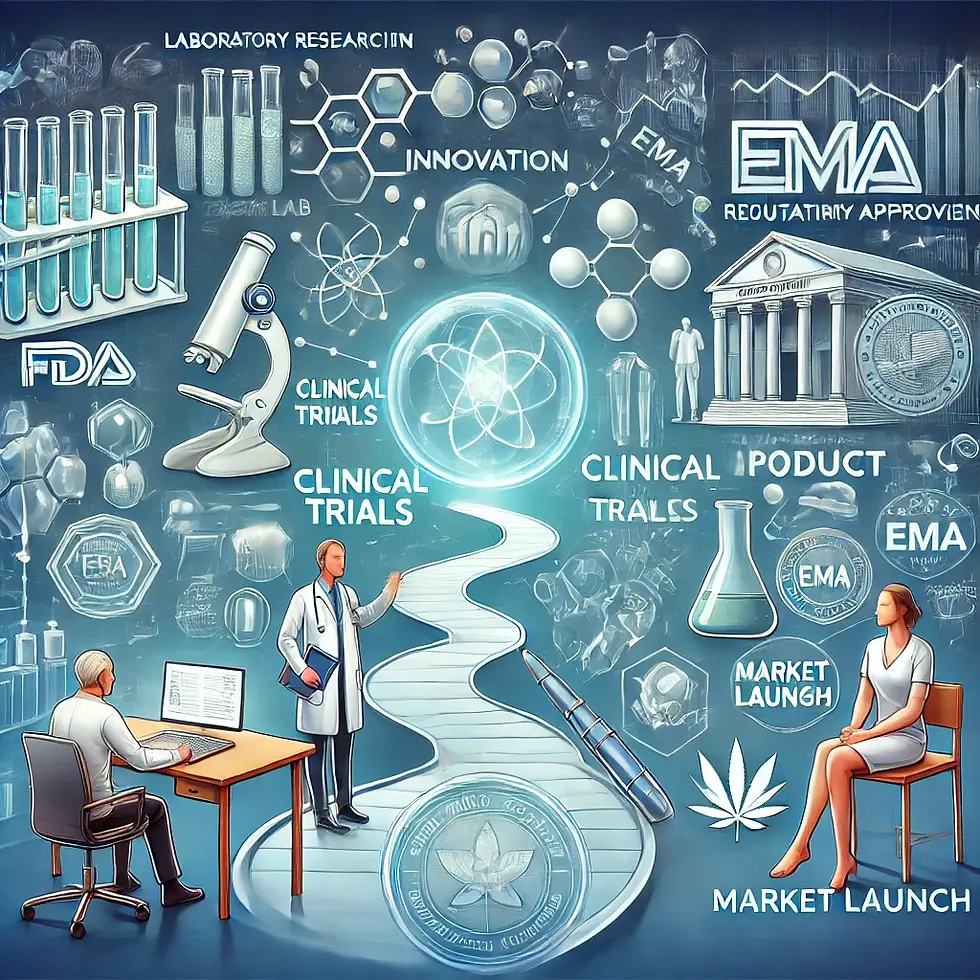The Path from Lab to Market: How Biomedical Inventions Become Commercial Products
- Joao Victor Cabral, MD Ph.D.

- Jan 24
- 3 min read
Updated: Feb 1

Bringing a biomedical innovation from the lab to market is a long and complex journey. Many groundbreaking discoveries never reach patients due to regulatory, financial, and logistical challenges. Understanding the commercialization process is crucial for scientists, entrepreneurs, and investors alike. This guide walks through the key steps of translating biomedical research into a successful commercial product, with a focus on the differences between the EU and USA regulatory landscapes.
1. From Discovery to Proof of Concept
All biomedical innovations begin with an idea—often derived from academic research or clinical observations. At this stage, researchers work on:
Identifying a biological target (for drugs) or developing a prototype (for medical devices).
Conducting feasibility studies to test initial viability.
Protecting intellectual property (IP) through patents.
While scientific curiosity drives research, early-stage commercial viability assessments help ensure that promising technologies have a clear path forward.
2. Preclinical Research and Patent Protection
Before moving to human trials, rigorous preclinical research is conducted, including:
In vitro (lab-based) studies to assess biological activity.
In vivo (animal) studies to evaluate safety and efficacy.
Securing intellectual property (IP) protection to prevent competitors from replicating the innovation.
Filing a provisional patent can help establish priority while the technology is further developed.
3. Regulatory Pathway and Clinical Development
Regulatory approvals are crucial before any biomedical technology can be marketed. Here’s how the process differs between the USA and the EU:
USA (FDA — Food and Drug Administration)
Drugs: Must go through the Investigational New Drug (IND) application, followed by Phase 1, 2, and 3 clinical trials before filing a New Drug Application (NDA).
Medical Devices: Devices are classified as Class I, II, or III, with higher-risk devices requiring Premarket Approval (PMA) or 510(k) clearance.
The FDA has a centralized approval process, ensuring a single nationwide standard.
EU (EMA — European Medicines Agency & MDR — Medical Device Regulation)
Drugs: Applications are submitted via the Centralized, Decentralized, or National procedures. The EMA oversees centralized applications for innovative medicines.
Medical Devices: The Medical Device Regulation (MDR) requires compliance with CE marking through Notified Bodies. The approval process depends on the risk classification of the device:
Class I (Low Risk): Self-certified by the manufacturer but must meet general safety and performance requirements.
Class IIa (Medium Risk) & Class IIb (Higher Medium Risk): Require assessment by a Notified Body to ensure compliance with MDR.
Class III (High Risk): Undergoes a thorough assessment by a Notified Body, including clinical evaluations and trials before CE marking.
The EU system allows country-specific variations and multiple regulatory bodies.
Understanding these differences is crucial for companies planning global commercialization strategies.
4. Market Analysis and Commercial Strategy
A robust commercialization strategy ensures a successful market launch. Key steps include:
Conducting market research to identify demand, competitors, and pricing models.
Developing a reimbursement strategy to secure coverage from insurers.
Choosing a business model, such as direct sales, licensing, or partnerships.
Funding from venture capitalists, grants, or corporate alliances is often necessary at this stage.
5. Manufacturing and Scale-Up
Biomedical products must meet Good Manufacturing Practice (GMP) standards to ensure quality. Considerations include:
Scaling up production while maintaining product consistency.
Meeting regulatory manufacturing requirements (GMP for drugs, ISO 13485 for devices).
Establishing supply chain logistics for efficient global distribution.
6. Market Launch and Post-Market Surveillance
Once regulatory approval is secured, companies must:
Deploy sales and marketing strategies to reach healthcare providers and patients.
Build distribution networks to ensure broad market access.
Monitor product performance through post-market surveillance (PMS) and real-world evidence studies.
Key Differences Between the EU and USA in Post-Market Surveillance
USA: The FDA mandates post-marketing safety studies (Phase IV trials) and has strict pharmacovigilance requirements.
EU: Under the MDR, manufacturers must conduct continuous clinical evaluations and submit periodic safety update reports.
Suggested Reading
For a deeper dive into biomedical commercialization, I recommend Commercializing Successful Biomedical Technologies by Shreefal S. Mehta. This book provides practical insights into product development, regulatory hurdles, and market entry strategies.
Conclusion
Bringing a biomedical innovation from the lab to market is a long, intricate process that requires strategic planning, regulatory navigation, and commercial foresight. The key differences between the EU and USA regulatory pathways impact how products are developed and marketed globally. By understanding these critical steps and adapting to different regulatory landscapes, innovators can maximize their chances of delivering life-changing medical solutions to patients worldwide.
Reference:
Mehta, S. S. (2008). Commercializing successful biomedical technologies. https://doi.org/10.1017/cbo9780511791345



Comments